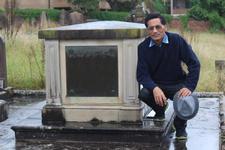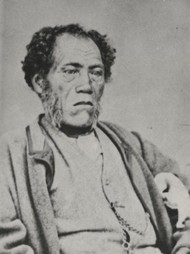
Transtasman ties recalled
A range of events are being planned across New Zealand in 2014 to celebrate the 200thyear of the Gospel being preached in New Zealand, but members of the Ratana faith are already honouring Samuel Marsden and his lasting legacy to Maori.
Members of the Ratana movement recently made their own pilgrimage to Marsden Cross at Oihi Bay and a number of other historic places that relate to the founding decades of Christianity and its influence own movement.
Now a group of are rallying with other Christians for a pilgrimage to honour the various missionaries to coincide with the centenary.
The challenge they’ve put out is that ‘pilgrims’ become familiar with the missionaries and the Christian history of various areas and share that with the group as they move up the country by bus or train to the bi-centenary
celebrations (I’ll post further details when I get clearance from the organisers).
Honouring the seed sower
Meanwhile a panui (announcement) was sent out out for Ratana members in Sydney to clean up the “badly overgrown” burial ground of Samuel Marsden, the O’Connell St Cemetery in Parramatta, New South Wales, the oldest English burial place in Australia, established in 1790.
“Come on E Te Iwi Morehu, time to say thank you to our Mihinare Haahi and in memory of Rev Samuel Marsden (Hamuera) for bringing the first Bible to Aotearoa in 1814,” came the request from apotoro rehita (registered apostle) Kereama Pene.
He’s called morehu (the scattered remnant) or Ratana followers from across New South Wales to gather on April 28th to give the place a spruce up and to remember Marsden and his major contribution to bringing Christianity to New Zealand.
The Ratana movement itself has a strong links to the area as the prophet Tahupotiki Wiremu Ratana, who attempted to restore the Gospel roots and the role of the Maori prophets in the history of Aotearoa, visited Marsden’s old mission station beside the Parramatta River around 16-17th April 1924.
He was accompanied by his 40-strong ‘world tour’ party on the way to England to try and have the Crown recognise the Treaty of Waitangi.(full details of this tour are included in my book Ratana- the Prophet).
Only three years earlier T.W Ratana found a broken piece of the original Marsden Cross when visiting at Oihi Bay in 1921 and later had it cemented in front of the Ratana Temple to commemorate the coming of the Gospel to Aotearoa.
Aboriginal conections
Rangihou Reserve, off New Zealand Street, in Paramatta is also considered a special place by Ratana members. This was where the first Church of England mission was established in Australia in 1793 and marks the place where Maori first encountered Aboriginals.
Rangihou, which means new heaven, received its name when the traditional owners, the Duhrug and Eora tribes gifted it as a tuku rangatira (land gift to the Church). On 30 September 2006 descendants of the Aboriginal donors gathered to meet Maori elders accompanying the Ko Tawaexhibition to Sydney.
The Maori representatives were greeted with a smoking ceremony; in turn they passed the mauri stone to the care of the Aboriginal people for the three months the exhibition will be in Australia.
(http://www.nzherald.co.nz/nz/news/article.cfm?c_id=1&objectid=10403608 ).
The reserve is an important toanga (treasure) to the growing number of Maori people living in Australia. In many ways the relationship between Maori and Rev Samuel Marsden and his legacy of bringing the Gospel to New Zealand receives more honour from Maori in Australia than it does from those in the country where he made such an impact.
Marsden hosted up to 20 Maori at a time at his Parramatta farm and mission station from 1805 onward including the Nga Puhi chief Te Pahi and Ruatara who invited him to New Zealand.
They and many others often received his hospitality, after being abused or mistreated as crewmen on whaling or sailing or trading ships. Marsden often bought them back to health and taught them the fundamentals of agriculture and horticulture. Te Pahi trusted Marsden so much that after taking back implements and grain and seed to New Zealand he sent his sons to learn new farming skills.
Marsden rescued Ngapuhi chief Ruatara who he found in a near death state on the ship Ann in 1809 just as he had received permission to establish a Church Missionary Society (CMS) mission station in New Zealand.
Marsden and his wife nursed Ruatara back to health and Ruatara hosted him when he preached the first Christian service on new Zealand soil (the full story is in my book Bible & Treaty – Missionaries Among the Maori)
The Gospel Bicentenary, celebrating the first sermon by Marsden in the Bay of Island on Christmas Day 1814 at the invitation of Ngapuhi chiefs, will take many forms, including a series of pilgrimages to Oihi Bay where that
message was first preached, along with church services, events and conferences
Events to celebrate Marsden’s include
Re-evaluating Christianity’s Influence in Shaping Aotearoa New
Zealand (1800- 1860)
Conference at Waitangi 27-29 November 2012
Organised by the 2014 Bicentenary History Group
Please feel free to add any events
or activities that will mark this time and we’ll build them into a more
comprehensive itinerary for the time. Or email
[email protected]
A range of events are being planned across New Zealand in 2014 to celebrate the 200thyear of the Gospel being preached in New Zealand, but members of the Ratana faith are already honouring Samuel Marsden and his lasting legacy to Maori.
Members of the Ratana movement recently made their own pilgrimage to Marsden Cross at Oihi Bay and a number of other historic places that relate to the founding decades of Christianity and its influence own movement.
Now a group of are rallying with other Christians for a pilgrimage to honour the various missionaries to coincide with the centenary.
The challenge they’ve put out is that ‘pilgrims’ become familiar with the missionaries and the Christian history of various areas and share that with the group as they move up the country by bus or train to the bi-centenary
celebrations (I’ll post further details when I get clearance from the organisers).
Honouring the seed sower
Meanwhile a panui (announcement) was sent out out for Ratana members in Sydney to clean up the “badly overgrown” burial ground of Samuel Marsden, the O’Connell St Cemetery in Parramatta, New South Wales, the oldest English burial place in Australia, established in 1790.
“Come on E Te Iwi Morehu, time to say thank you to our Mihinare Haahi and in memory of Rev Samuel Marsden (Hamuera) for bringing the first Bible to Aotearoa in 1814,” came the request from apotoro rehita (registered apostle) Kereama Pene.
He’s called morehu (the scattered remnant) or Ratana followers from across New South Wales to gather on April 28th to give the place a spruce up and to remember Marsden and his major contribution to bringing Christianity to New Zealand.
The Ratana movement itself has a strong links to the area as the prophet Tahupotiki Wiremu Ratana, who attempted to restore the Gospel roots and the role of the Maori prophets in the history of Aotearoa, visited Marsden’s old mission station beside the Parramatta River around 16-17th April 1924.
He was accompanied by his 40-strong ‘world tour’ party on the way to England to try and have the Crown recognise the Treaty of Waitangi.(full details of this tour are included in my book Ratana- the Prophet).
Only three years earlier T.W Ratana found a broken piece of the original Marsden Cross when visiting at Oihi Bay in 1921 and later had it cemented in front of the Ratana Temple to commemorate the coming of the Gospel to Aotearoa.
Aboriginal conections
Rangihou Reserve, off New Zealand Street, in Paramatta is also considered a special place by Ratana members. This was where the first Church of England mission was established in Australia in 1793 and marks the place where Maori first encountered Aboriginals.
Rangihou, which means new heaven, received its name when the traditional owners, the Duhrug and Eora tribes gifted it as a tuku rangatira (land gift to the Church). On 30 September 2006 descendants of the Aboriginal donors gathered to meet Maori elders accompanying the Ko Tawaexhibition to Sydney.
The Maori representatives were greeted with a smoking ceremony; in turn they passed the mauri stone to the care of the Aboriginal people for the three months the exhibition will be in Australia.
(http://www.nzherald.co.nz/nz/news/article.cfm?c_id=1&objectid=10403608 ).
The reserve is an important toanga (treasure) to the growing number of Maori people living in Australia. In many ways the relationship between Maori and Rev Samuel Marsden and his legacy of bringing the Gospel to New Zealand receives more honour from Maori in Australia than it does from those in the country where he made such an impact.
Marsden hosted up to 20 Maori at a time at his Parramatta farm and mission station from 1805 onward including the Nga Puhi chief Te Pahi and Ruatara who invited him to New Zealand.
They and many others often received his hospitality, after being abused or mistreated as crewmen on whaling or sailing or trading ships. Marsden often bought them back to health and taught them the fundamentals of agriculture and horticulture. Te Pahi trusted Marsden so much that after taking back implements and grain and seed to New Zealand he sent his sons to learn new farming skills.
Marsden rescued Ngapuhi chief Ruatara who he found in a near death state on the ship Ann in 1809 just as he had received permission to establish a Church Missionary Society (CMS) mission station in New Zealand.
Marsden and his wife nursed Ruatara back to health and Ruatara hosted him when he preached the first Christian service on new Zealand soil (the full story is in my book Bible & Treaty – Missionaries Among the Maori)
The Gospel Bicentenary, celebrating the first sermon by Marsden in the Bay of Island on Christmas Day 1814 at the invitation of Ngapuhi chiefs, will take many forms, including a series of pilgrimages to Oihi Bay where that
message was first preached, along with church services, events and conferences
Events to celebrate Marsden’s include
Re-evaluating Christianity’s Influence in Shaping Aotearoa New
Zealand (1800- 1860)
Conference at Waitangi 27-29 November 2012
Organised by the 2014 Bicentenary History Group
Please feel free to add any events
or activities that will mark this time and we’ll build them into a more
comprehensive itinerary for the time. Or email
[email protected]

 RSS Feed
RSS Feed
